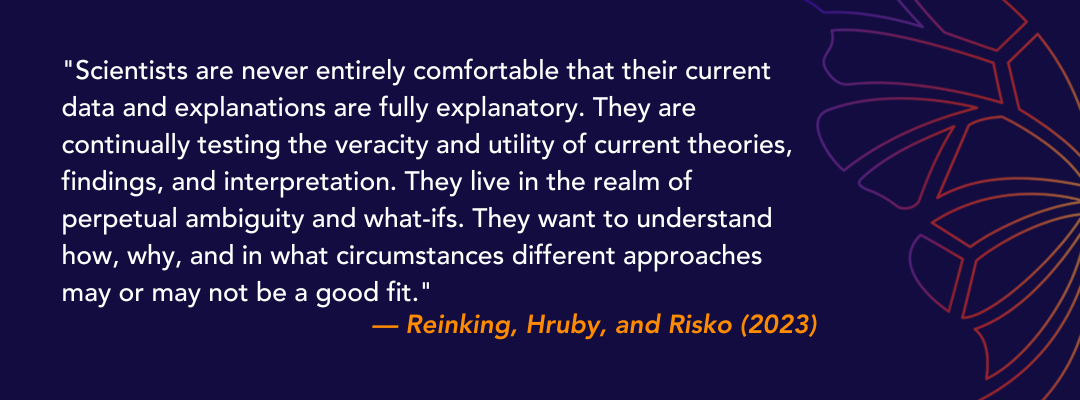Data shows that our learners continue to lack reading and literacy skills both in the classroom and in the workplace. If we want to improve reading comprehension and develop excellent and literate readers who can function effectively in school, the workplace, and in our communities, then we must use a blend of valid and reliable research-based strategies. The strategies we select and implement must connect the whole brain to reading, writing, speaking, listening, and deep comprehension. Most importantly, we must implement artifact-based strategies because this is the only way we will be able to gauge our learners’ depth of comprehension.
In order to select and implement effective reading strategies we must open-mindedly dive deeper into comprehensively reading the science of reading. Let’s take a deeper dive into the science of reading with a focus on the learners, the most important people in education. As you explore the following sections in this blog use these questions as your reading lens.
- Am I focusing on my learners’ needs and selecting and using high-level artifact-based strategies that will improve reading and literacy?
- Am I defending strategies that have been used time after time yet do not provide students with improved reading and literacy skills?
- Am I using valid and reliable strategies? Do I consider strategies as reliable and valid only because everyone is using them?
A Deeper Dive into Comprehensively Reading the Science of Reading
The Science of Reading (SoR) strategies or more significantly the Reading of Science (RoS) strategies that provide excellent results, go way beyond phonics, phonemics, fluency, and vocabulary. The Reading of Science (RoS) term is used here to help us be more aware that science is ever-changing, includes many perspectives, and cumulates or blends multiple viewpoints and data before a hypothesis is formed and tested. The Reading of Science term (RoS) is also used because as educators, we are becoming more open-minded and inclusive of valid ideas that are not generally highlighted and implemented. We must make sure that the reading of science is comprehensive when suggesting and using Science of Reading (SoR) strategies.

Take note of the quote above and let it be one that resonates with you. Are we truly implementing the best findings and interpretations of the Science of Reading research that can be used to meet the needs of all learners and push our students to their fullest potential?
Our students come to us with unique abilities, circumstances, and needs. Are we using diverse strategies that meet the needs of each student?
If empirically valid research provides specific strategies to support struggling readers with learning disabilities, then those strategies should only be used with students who have learning disabilities, with the simultaneous goal of attaining and depicting deep comprehension skills using artifact-based techniques. We must also correctly identify students with learning disabilities since signs can be misleading, and it can be very easy to inaccurately categorize a student as having a reading or learning disability.
It is very important to note that strategies geared to supporting struggling learners should not be used with students who do not have learning disabilities. In order to close the equity gap in education, we must provide non-struggling readers with immediate opportunities to attain deep comprehension skills using individualized learner-unique differentiation strategies and artifact-based techniques.
The Whole Brain and Deep Reading Comprehension
When it comes to reading comprehension, we need more research that supports the connections to the whole brain. Research on reading strategies generally focuses on the left side of the brain, but these are research-related strategies that were used in helping learners with disabilities pronounce words instead of engaging in deep comprehension.
Around 1990, when fMRI (functional Magnetic Resonance Imaging) was invented, prevalent research continued to focus on analyzing the left side of the brain. However, it is stated that “fMRI affords tentative implications but significant constraints, including its failure to assess brain activity over time, its failure to register brain activity that has occurred, and the lack of resolution found in the images (Tierney & Pearson, 2024).
It is known that the right side of the brain is responsible for creativity, spatial ability, imagination, and intuition; and it plays an important part in reading and interpretation, through connections to images and personal experiences. The authors of the review paper, The Margins of the Language Network in the Brain, found that “the right brain plays a key role in understanding context and non-literal language, such as metaphors and irony.” They also stated that “the right brain’s spatial awareness helps us understand and visualize language.” However, if we keep looking for connections to the left brain that are only linked to word pronunciation, we will find them, but we will fail to focus on the profound impact of neuroplasticity and neural network connections and formations in the whole brain in attaining and depicting deep comprehension.
When we do focus on the left side of the brain, it is very important to emphasize its profound functions and connections to deep comprehension instead of just spoken words. The occipital-temporal region plays a significant role in processing and interpreting information relating to images and text and it “continually responds to information from the surrounding world” (Hampton, n.d). Additionally, the occipital-temporal region is responsible for facial recognition from birth, which transitions to the recognition of letters, letter patterns, prints, and interpretations in the early years of children’s lives.
Our learners are different and bring unique cumulative connections and experiences from birth. As such, we must capitalize on all of these experiences and implement differentiated reading strategies and artifact-based reading techniques to meet their individual needs.
If you really want to discover the depth and wealth of the unique knowledge, understanding, and connections your learners bring, and heighten their comprehension level, then you cannot use a one-size-fits-all reading approach to reading. One of the best ways to determine and heighten students’ depth of comprehension is to use a SAGE Approach to Reading the Science of Reading and Student Write strategies
History of the Science of Reading
One of the many important historical connections to the science of reading is rooted in the research done in the 1930s and 1940s by a neurologist, Dr. Samuel Orton, and educator Anna Gillingham. Their research and passionate work focused on helping struggling readers with learning disabilities attain mastery by using phonics-based instruction. Furthermore, their research focused on determining a connection between the left hemisphere of the brain and pronouncing words, based on work done with brain-damaged adults.
Being experts in their fields, I believe their strategies provided the scaffolded support and interventions needed to help learners with disabilities pronounce words better. What I don’t believe is that they wanted to keep students with learning disabilities at the pronunciation level or use their research-based strategies with students who do not have learning disabilities. Based on the intense focus on learning disabilities and the left brain, it can be stated that the science of the whole brain and its impact on deep comprehension was not fully explored.
Research supports reading practices that focus on deep comprehension and providing all learners with an equitable education. Therefore, we must focus on the comprehensive Reading of Science (RoS) approach. This approach pushes us to dig deeper into the Science of Reading (SoR) and to focus on the whole brain. It also drives us to incorporate authentic, rigorous, and meaningful reading strategies that help learners acquire the skills of deep comprehension and meaningful application of knowledge.
If learning is about our students, then we need to dive deeper into reading the Science of Reading and identifying and implementing impactful, valid, artifact-based reading strategies that will allow learners to generate excellent learning products. However, we can’t dive deeply into comprehensively reading the science of reading and be a change agent if we don’t explore those thought-provoking questions and alternative views of the Reading of Science that push our thinking.
The SAGE Approach to the Science of Reading
Valid and reliable research supports reading practices that focus on depicting deep comprehension. If we want to improve reading comprehension and develop literate readers who can function effectively in school and the workplace, then we must change our reading techniques to a SAGE approach. We must use a blend of valid and reliable research-based reading strategies that focus on the whole brain and allow students to depict deep comprehension through artifact-based reading.
The below SAGE Science of Reading Framework that incorporates true Science of Reading ideas to help learners and educators focus on incorporating research-based reading comprehension strategies which have proven time after time to profoundly increase deep comprehension skills.

Allow learners to select and use Student Write strategies for inferencing and synthesizing and creating artifacts to represent knowledge gained when reading text. Reading goes way beyond phonics, phonemics, fluency, and vocabulary. Therefore, it is very important to go beyond fluency, reading rate, and isolated vocabulary and provide learners with extensive time to use student selected Student Write strategies to represent their deep comprehension of text. The goal of reading is comprehension. The goal of reading is comprehension. How are learners using Student Write Strategies to represent their comprehension of text profoundly?

Give learners time to engage in meaningful “Student Read-Write-Talk-Listen” activities simultaneously. The Wernicke’s area in the brain makes sense of spoken and written language by connecting to images, prior knowledge, learners’ personal experiences, and more. Learners have been naturally immersed in a world of sound from birth, so meaningful spoken language is very important as it incorporates what has already been in place. A Reading-Writing-Speaking-Listening focus develops the process of orthographic mapping and very importantly neuroplasticity to build neural circuitry and stronger neural networks for deep comprehension.

Growth mindset is a neuroscience connected skill focused on the neural growth actions of embracing change and challenges, persisting through obstacles, developing grit, overcoming limiting beliefs, and so much more. Learners need ongoing guidance on how to develop and focus on a growth mindset when creating high-level and excellent comprehension artifacts. Representing comprehension is not and will never be a one-time practice. Learners must embrace the growth mindset of editing and revising multiple versions of initial written drafts to create excellent learning products by engaging in ongoing self-reflection and metacognition, and implementing meaningful feedback.

Student Write reading strategies need to be implemented across curriculum and content, with the premise that all teachers are reading teachers. Increasingly, books and education programs are indicating that reading is no longer a subject, but a profound pedagogical strategy that strongly focuses on having learners represent what they comprehend. To further deepen comprehension, Student Write reading strategies must be coupled with extensive time for students to engage in research, design, revision and revision within and outside of the classroom walls, to support the creation of excellent learning products, and the development of stronger neural connections and literacy skills.
In the upcoming part of this series, we’ll explore alternative perspectives that invite you to question and reflect on the validity and reliability of the reading strategies you rely on. This exploration will encourage you to critically assess the foundation and effectiveness of your reading teaching methods, sparking a renewed understanding of the science of reading.
Subscribe to the K12 Hub or check on December 2nd for A Sage Approach to The Science of Reading: Part 3 – Are We Reading the Science of Reading Correctly?
Did you miss Part 1 or want to refresh your memory? Dive into A SAGE Approach to the Science of Reading: Part 1 – A Need for Artifact-Based Reading Strategies.
About the Author
Cherry-Anne Gildharry holds a Bachelor of Science in Mathematics, a Master of Science in Education, and a Graduate Certificate in Instructional Coaching. With 29 years of experience in education, she has worked across various locations, including Trinidad and Tobago, North Carolina, Iowa, Texas, and other parts of the U.S. Throughout her career, Cherry-Anne has held numerous roles, such as High School and Middle School Math Teacher, Department Chair, and Teacher Leader. She has also served as an Algebra 1 and Geometry Lead Teacher, Workshop Creator and Facilitator, and Marzano’s Demonstration Teacher. Additionally, she has been a School-Based and District Coach, Leadership Coach and Collaborator, Learning Design Strategist, Virtual Instructional Coach, Professional Development Auditor, and Professional Development Content Creator.
Cherry-Anne has established a notable record of success both as a teacher and a coach. In North Carolina, 100% of her Algebra 1 and Geometry students achieved passing scores for consecutive years. Furthermore, teachers she coached, including those from Teach for America, saw their students achieve similar success rates.
Fun Fact: Cherry-Anne loves globe-trotting with her wife Melanie Gildharry! To date, they have traveled to all 50 states and 47 countries with 25 of them being European countries. Cherry-Anne took her first international flight from Trinidad and Tobago at age 9 to the United Kingdom to visit Scotland and England.
References
Bromley, M. (2017, June 14). Every teacher is a teacher of literacy: Literacy practice across the
curriculum. SecEd. https://www.sec-ed.co.uk/content/best-practice/every-teacher-is-a-teacher-of-
literacy-literacy-practice-across-the-curriculum
Building the Reading Brain | Zaner-Bloser. (n.d.). Www.zaner-Bloser.com.
https://www.zaner-bloser.com/research/building-the-reading-brain.php
Cartwright, K., & Mermelstein, L. (2023, September 21). 7 Ways to Put the Science of Reading
Into Practice with the Active View of Reading. Learning without Tears.
https://www.lwtears.com/blog/7-ways-put-science-reading-practice-active-view-reading
Cohen, R. M. (2023, August 15). The new “science of reading” movement, explained. Vox.
https://www.vox.com/23815311/science-of-reading-movement-literacy-learning-loss
eSoft Management Consultants. (2023, October 14). Cultivating A Growth Mindset: A Complete
Guide. Online Business School.
https://esoftskills.com/cultivating-a-growth-mindset-a-complete-guide/
Graham, S. (2019). Changing How Writing Is Taught. Review of Research in Education, 43(1),
277–303. https://doi.org/10.3102/0091732×18821125
Hampton, L. (n.d.). Occipital Lobe. Physiopedia. https://www.physio-pedia.com/Occipital_Lobe
Hanford, E. (2018, September 10). Why aren’t kids being taught to read? www.apmreports.org
https://www.apmreports.org/episode/2018/09/10/hard-words-why-american-kids-arent-being-
taught-to-read
Harrington-Atkinson, T. (2021, August 5). Reading – A Four-Step Process. Paving the Way.
https://tracyharringtonatkinson.com/reading-a-four-step-process/#google_vignette
Healthline Media. (n.d.). Left brain vs. right brain: What’s the difference? Healthline.
https://www.healthline.com/health/left-brain-vs-right-brain#research
Hertrich, I., Dietrich, S., & Ackermann, H. (2020, September 30). The margins of the
language network in the brain. Frontiers
https://www.frontiersin.org/journals/communication/articles/10.3389/fcomm.
2020.519955/full
Heubeck, E., & Borowski, J. (2023, October 27). What is the orton-gillingham method for
teaching reading?. Education Week. https://www.edweek.org/teaching-learning/what-
is-the-orton-gillingham-method-for-teaching-reading-video/2023/10
Hutner, N. (1991). Right hemisphere participation in reading*1. Brain and
Language, 41(4), 475–495. https://doi.org/10.1016/0093-934x(91)90169-2
Jenae. (2022, February 24). How our brains learn to read. Pathways to Reading
Homeschool.https://pathwaystoreadinghomeschool.com/how-our-brains-learn-to read/
Mahowald, C. (n.d.). Six Reading Comprehension Strategies Families Can Practice Together At
Home. Parent Powered. https://parentpowered.com/blog/science-of-reading/comprehension-
strategies/
Nielsen, J. A., Zielinski, B. A., Ferguson, M. A., Lainhart, J. E., & Anderson, J. S. (2013).
An evaluation of the left-brain vs. right-brain hypothesis with resting state functional
connectivity magnetic resonance imaging. PLoS ONE, 8(8).
https://doi.org/10.1371/journal.pone.0071275
Orton-Gillingham | About Orton and Gillingham. (n.d.). Teresa Garretson Site.
https://www.orton-gillingham.com/about-orton-and-gillingham/
Stewart, L. (n.d.). The Science of Reading: Evidence for a New Era of Instruction.
Zaner-Bloser.com. https://www.zaner-bloser.com/research/the-science-of-reading-evidence-for-a-
new-era-of-reading-instruction.php
Staake, J. (2022, June 17). What Is the Science of Reading? We Are Teachers.
https://www.weareteachers.com/what-is-the-science-of-reading/
Stevens, E. A., Austin, C., Moore, C., Scammacca, N., Boucher, A. N., & Vaughn, S.
(2021). Current State of the Evidence: Examining the Effects of Orton-Gillingham
Reading Interventions for Students with or at Risk for Word-Level Reading
Disabilities. Sage Journal. 87(4), 397–417. https://doi.org/10.1177/0014402921993406
ScienceDaily. (2003, May 19). Was Orton right? A new study examines how the brain
works in reading; offers key to better understanding dyslexia. ScienceDaily.
https://www.sciencedaily.com/releases/2003/05/030519083450.htm
Science of Reading. (n.d.). The Reading Center.
https://www.thereadingcenter.org/science-of-reading
The Science of Reading Resource Hub. (n.d.). Www.zaner-Bloser.com. Retrieved October 15,
2022, from
https://www.zaner-bloser.com/science-of-reading-resource-hub.php?wvideo=w1g71oepvr
The Science of Reading. (n.d.). Brainspring.com.
https://brainspring.com/why-professional-development/
Tierney, R., & Pearson, D. (2024). First Edition FACT-CHECKING THE SCIENCE OF READING.
https://literacyresearchcommons.org/wp-content/uploads/2024/04/Fact-checking-the-SoR.pdf
UNESCO. (2024, January 31). What you need to know about literacy. UNESCO
https://www.unesco.org/en/literacy/need-know







